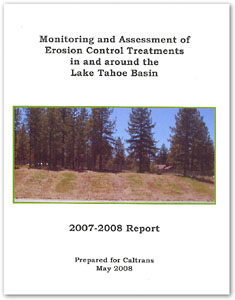Erosion Control Toolbox: Research, Monitoring and Assessment
Introduction
NativeRevegetation.org offers valuable research resources for landscape architect designers relating to research, monitoring and assessment of projects. Below is a sample web page screen shot.
![]()
Tahoe Erosion Control Monitoring (Michael Hogan)

Executive Summary(PDF)
- The above document does a very good job summarizing the findings of the documents listed below.
Brockway Fill Slopes (PDF)
Brockway Test Plots (PDF)
Heavenly Canyon (PDF)
Myers Airport (PDF)
Northstar Lookout (PDF)
Northstar Unit 7 (PDF)
Resort at Squaw Creek (PDF)
Tahoma Soil Boxes (PDF)
Truckee Bypass (PDF)
Washington "Sea" Streets Monitoring
"The 2nd Avenue SEA Streets project has prevented the discharge of all dry season flow and 98 percent of the wet season runoff. It can fully attenuate the runoff volume produced by approximately 0.75 inch of rain on its catchments. Based on estimates for a street drainage system design according to City of Seattle conventions, the SEA Streets alternative reduces runoff discharged to Pipers Creek in the wet months by a factor of 4.7 relative to the conventional street."
Take the SEA Streets Virtual Tour.
VIC Claassen
Regeneration of Nitrogen Fertility in Disturbed Soils Using Compost (PDF) Graphs nitrogen release from various composts and compares compost release rates with two native topsoils.
Compost Use for Erosion Control And Improved Stormwater Quality (PDF)
Annual Sediment, Nitrogen and Phosphorus Losses From Bare And Compost Amended Fill Slopes(PDF)
University Of Washington
Investigation of the Feasibility and Benefits of Low-Impact Site Design Practices for the San Diego Region
The assessment of basins, biofiltration, and low-impact design practices analyzed the expected infiltration capacity of the case study sites. It also considered related LID techniques and practices, such as source reduction strategies, that work in concert with infiltration to serve the goals of:
- Preventing increase in annual runoff volume from the pre- to the post-developed state
- Preventing increase in annual pollutant mass loadings between the two development states, and
- Avoiding exceedences of California Toxics Rule (CTR) acute saltwater criteria for copper and zinc.
This report shows low-impact site design techniques to be capable of regaining the groundwater recharge lost in development to a greater extent than conventional BMPs. At the same time LID techniques substantially preserve predevelopment hydrologic conditions and prevent most or all pollutant transport to receiving waters.
State Of California
California Department of Transportation, "Performance of Erosion Control Treatments on Reapplied Soil", May 2005 (PDF)
Updated: December 13, 2018

